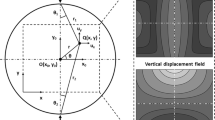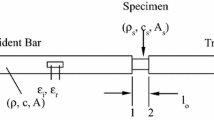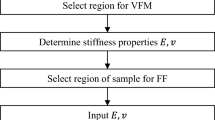Abstract
Brazilian disk compression has been proposed as an alternative for measuring elastic constants of brittle solids with very low tensile strength (Hondros, Aust J Appl Sci 10:243–268, 1959). Subsequently however, the Brazilian disk geometry was mainly used for measuring fracture toughness and tensile strength of brittle materials, like rocks and concretes. In this study, we revisit the Brazilian disk specimen as a tool for determining elastic constants and for observing the deformation process up to failure. We used the optical digital image correlation (DIC) technique to obtain the displacement field on the specimen surface and proposed a scheme for determining the elastic constants from the measured displacement field and the applied load. Details of the elastic constant determination of a homogeneous material, epoxy resin, were presented. Comparison of the elastic constant measured using Brazilian disk with those obtained through more conventional means was carried out. We also present observations of the deformation evolution of the epoxy resin disk subjected to large nonlinear deformation up to failure and subjected to compressive loading and unloading.








Similar content being viewed by others
References
Hondros G (1959) The evaluation of Poisson’s ratio and the modulus of materials of a low tensile resistance by the Brazilian (indirect tensile) test with particular reference to concrete. Aust J Appl Sci 10:243–268
Mellor M, Hawkes I (1971) Measurement of tensile strength by diametral compression of discs and annuli. Eng Geol 5:173–225
Hudson JA, Brown ET, Rummel F (1972) The controlled failure of rock discs and rings loaded in diametral compression. Int J Rock Mech Min Technol 9:241–248
Fairhurst C (1964) On the validity of the ‘Brazilian’ test for brittle materials. Int J Rock Mech Min Sci 1:535–546
Andreev GE (1991) A review of the Brazilian test for rock tensile strength determination. Part I: calculation formula. Min Sci Technol 13:445–456
Andreev GE (1991) A review of the Brazilian test for rock tensile strength determination. Part II: contact conditions. Min Sci Technol 13:457–465
Wang QZ, Jia XM, Kou SQ, Zhang ZX, Lindqvist P-A (2004) The flattened Brazilian disc specimen used for testing elastic modulus, tensile strength and fracture toughness of brittle rocks: analytical and numerical results. Int J Rock Mech Min Sci 41:245–253
Awaji H, Sato S (1978) Combined mode fracture toughness measurement by the disk test. Engineering Materials and Technology 100:175–182
Chu TC, Ranson WF, Sutton MA, Peters WH (1985) Applications of digital image correlation techniques to experimental mechanics. Exp Mech 25:232–244
Bruck HA, McNeil SR, Sutton MA, Peters WH (1989) Digital image correlation using Newton-Raphson method of partial differential correction. Exp Mech 29:261–267
Vendroux G, Knauss WG (1998) Submicron deformation field measurements: part 2. Improved digital image correlation. Exp Mech 38:86–92
Muskhelishvili NI (1953) Some basic problems in the mathematical theory of elasticity (translated by J. R. M. Radok). Noordhoff, Groningen
Acknowledgements
This study was supported by the Joint DoD/DOE Munitions Program and by the Enhanced Surveillance Campaign. The author also wants to thank Drs. Matthew W. Lewis and Philip Rae of Los Alamos National Laboratory for the valuable comments.
Author information
Authors and Affiliations
Corresponding author
Appendix: Elastic Solution of a Circular Disk
Appendix: Elastic Solution of a Circular Disk
For planar deformation, either plane strain or plane stress, in a given Cartesian coordinate system (x, y), the in-plane stress components are denoted by σ x , σ y , and τ xy , and the displacement components by u and v, respectively. By introducing a complex variable z = x + iy in the region ℝ, there exist two functions, ϕ(z) and ψ(z), which are analytic for z, such that the stress can be related to ϕ(z) and ψ(z) through
and the displacement be represented by
where the constant κ = (3 − ν)/(1 + ν) for plane stress and κ = 3 − 4 ν for plane strain, respectively, and μ is the shear modulus, ν the Poisson’s ratio. In equations (2) and (3), the bar over a symbol stands for the complex conjugate.
Let ℝ be a circular region with radius R, i.e., ℝ, and the boundary of the region, \(\partial\mathbb{R}\), be described by \(\lvert{z}\rvert = R\), or by points \(\xi = R\exp(i\,\theta)\) (\(0 \leqslant \theta \leqslant 2\pi\)). Along \(\partial\mathbb{R}\) and measuring from θ = 0, let the resultant force over the arc, \(0 \leqslant \eta \leqslant \theta\), be denoted by f(ξ). The distribution of f(ξ) over \(\partial\mathbb{R}\) is in self-equilibrium, i.e., the resultant force and the resultant moment over the entire \(\partial\mathbb{R}\) vanish. The two analytic functions, ϕ(z) and ψ(z), can be obtained to be [12]:
where
From equation (5), we see that for existence of a solution for the problem, the right-hand side of equation (5) must be real. This is equivalent to the requirement that the resultant moment of the applied force over the boundary \(\partial\mathbb{R}\) must vanish. We also know that the imaginary part of α 1 can be arbitrarily chosen without affecting the stress. Therefore, we may choose that \({\rm{Im}}\{\alpha_{1}\} = 0\), and hence
Now consider that a pair of concentrated forces represented by P = F x + i F y , where F x and F y are both real, acting on the circular boundary \(\partial\mathbb{R}\) at two locations
The resultant force function f(ξ) is thus
As a result,
and
where we have used the relation \(\overline{\xi} = R\exp(-i\,\theta) = R/\exp(i\,\theta) = R^{2}/\xi\) along the boundary \(\partial\mathbb{R}\). Also note that α 1 should be a real number.
From equation (4), the analytic functions ϕ(z) and ψ(z) are given by
By using equations (2) and (3), the stresses and the displacements within the circular disk are
and
Finally, let us consider the special case, where a pair of concentrated compressive forces with the magnitude F, acting across the diameter of the circular disk along the y direction. The locations, where the forces are applied, are ξ 1 = i R and ξ 2 = − i R, respectively, and P = − i F, where F represents the compressive force per unit thickness of the two-dimensional disk. In the Cartesian system (x, y) with origin located at the center of the disk, the stresses and the displacements can be expressed as
and
Note that for the boundary condition of prescribed traction and for elastic deformation, the stress distribution within the circular disk does not depend on the elastic constants of the body. This property holds for any elastic problem of a two-dimensional simply-connected region composed of homogeneous and isotropic elastic solid.
For the case where the compressive force is distributed over a finite region, we first consider the problem as shown in Fig. 9. The stresses and the displacements within the disk sample can be calculated using the Green’s functions given below. Let δ 1 = π/2 − α and δ 2 = 2π − (π/2 − α), where α represents the variable angle shown in Fig. 9. Thus, the two complex variables ξ 1 and ξ 2 in equation (8), are \(\xi_{1} = R \exp(i(\pi/2 - \alpha))\) and \(\xi_{2} = R \exp(-i(\pi/2 - \alpha))\). Also, let the concentrated force P = − i(δF), where δF is real. Then from equations (9) and (10), we have
and
One may check that by setting α = 0 and δF = F in equations (13) and (14), equations (11) and (12) are recovered. For the contact of an elastic circular disk with a rigid flat surface, as depicted in Fig. 2(a), the variation of the distributed traction, δF/δη, is given by
where b is the half width of the contact region shown in Fig. 9, and the constant σ 0 and the length b are related to the total applied compressive force F by
Finally, the stresses and the displacements within the disk sample can be obtained by
and
We need to point out that although contact loading is considered here, the formulation is still based upon the assumption of infinitesimal deformation, i.e., b ≪ R. Some of the numerical results are shown in Fig. 2.
Rights and permissions
About this article
Cite this article
Liu, C. Elastic Constants Determination and Deformation Observation Using Brazilian Disk Geometry. Exp Mech 50, 1025–1039 (2010). https://doi.org/10.1007/s11340-009-9281-2
Received:
Accepted:
Published:
Issue Date:
DOI: https://doi.org/10.1007/s11340-009-9281-2





